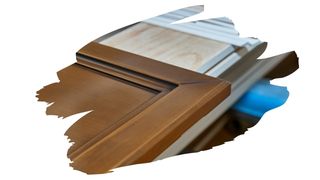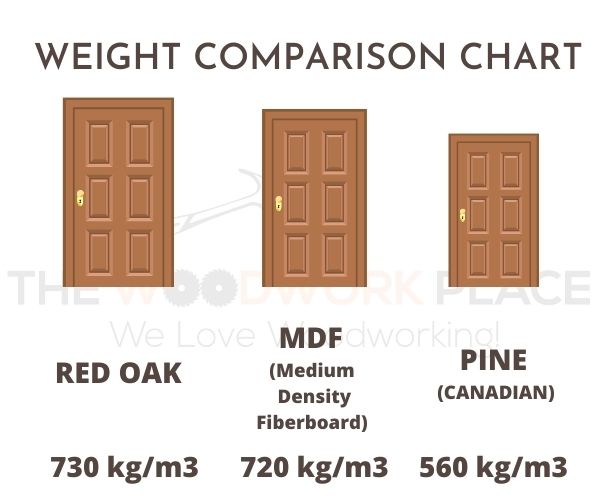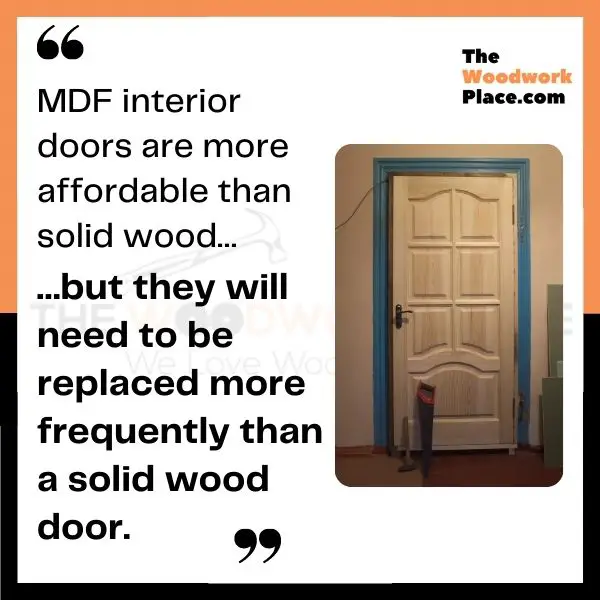MDF, (also known as Medium Density Fiberboard), is a pretty versatile material.
It’s smooth enough to paint, without needing any further prep. It’s sustainable, thanks to the fact that it’s made from recycled wood waste. And it can be bought for just a fraction of the cost of solid natural wood.
However, if you dig a little deeper, you’ll discover that there is a lot more to MDF than meets the eye.
So, in this quick guide, you will learn why MDF doors can feel more stable and sturdy than natural solid wooden doors. You will also discover why an MDF interior door could be ideal for your home recording studio.
And we reveal the real reason why MDF should rarely (if ever) be used for a kitchen or bathroom door.

This post may contain affiliate links to products that we receive a commission for (at no additional cost to you). Learn more here.
First Off, How Are Solid MDF Interior Doors Made?
Medium Density Fiberboard interior doors are made from discarded wood chips. These left over wood shavings, and sawdust, get recycled and manufactured into dense smooth sheets.
Related Post: Just What Is Manufactured Wood Anyway?
All of those wood shavings are packed tightly and bonded together using a formaldehyde-based glue. Which is why, if you work with MDF, you must always wear an air filtration dust mask.
That is because routing and sawing MDF will create a lot of toxic fine dust. This dust is painful to inhale, and can do a lot of damage to your health.
Related Post: Can You Use A Router On MDF? (Solved!)

Are MDF Interior Doors Solid?
Well, interior doors are generally available in three main ‘core’ types; hollow core, solid core, and solid wood.
Hollow Core Interior Doors: These doors are constructed with a veneer frame. However, at their core is a honeycomb void-filled center (that’s made of either plastic or cardboard).
Solid Core Interior Doors: These types of doors are also constructed with a veneer frame. However, at their core is a tightly packed manufactured composite wood, (such as MDF).
Solid Wood Interior Doors: Now, these types of doors are solid wood through and through. They are not structured using a veneered frame, and they do not contain any composite wood. Instead, they’re made from solid 100% natural wood through and through.
You can get MDF interior doors in either a hollow core or solid core frames.
MDF Solid Core Vs Natural Solid Wood Doors
If you purchase a solid core MDF door, you will have a hefty stable door that’s heavier than most solid wood alternatives.
That is because MDF is denser than natural hardwood, (although MDF weighs just a little less than oak).

This makes MDF great at absorbing sound. And, with it’s added weight, an MDF door can feel more sturdy than natural solid wood doors.
Pros: What Are The Top 3 Advantages Of MDF Interior Doors?
1). Stability
Thanks to its engineered qualities, MDF wood is very stable. Especially when compared to natural wood… and here’s why.
When we first cut down a tree for lumber, we need to let it dry out before we can begin using it to make doors and furniture. This drying process is known as ‘seasoning’.
Related Post: How To Season Wood (7 Tips)
What Is Seasoning? And Why Does It Matter For Door Stability?
Seasoning is a process that aims to reduce the moisture content of freshly cut ‘green’ wood. The goal is to get green woods moisture content down from 100%, to under 20%.
Now, as wood seasons and dries out, it will shift, shrink and swell. And often times, (even after that timber has finished seasoning), it can continue to go through seasoning-like shrinkage.
As a result, natural solid wood can continue to shift around with any changes in temperature… even years after having been turned into a door, furniture, or hardwood flooring.
Related Post: Do New Hardwood Floors Need To Settle? (Explained!)
There are some natural types of solid wood that don’t continually shift around like this. For example, Douglas Fir wood is incredibly stable, and it barely moves around after it has been seasoned.
Related Post: What Is The Best Treatment For Douglas Fir Porch Decking?
So, Why Is MDF’s Stability Good For Internal Doors?
MDF’s stability means that it won’t keep moving around due to the slightest change in temperature or humidity. So, an MDF interior door won’t end up twisting off its hinges as it shifts around.

2). Noise Reduction
If you live in a very noisy household, (or you want to create your own home studio), then an MDF door is going to work wonders at absorbing sound.
Are MDF Doors Soundproof?
Solid core MDF doors are very soundproof, thanks to their high density.
Natural solid wood is already a great sound insulator. But, the densely packed wood chips inside MDF will double down on that whole dampening effect.
As a result, MDF doors significantly reduce noise levels, more so than solid wood.
3). Affordability
MDF doors are a cost-effective way to furnish those entryways.
It’s cheaper than other engineered woods, such as plywood. And it is much, much more affordable than Pine or Alder, (which are two popular natural timber options for making solid wood doors).

Cons: What Are The Top 3 Disadvantages Of MDF Interior Doors?
1). Weak Joints
MDF isn’t the easiest thing to fasten using nails and screws. The best way to get this composite material to stay in place is by using strong glue.
But, glue isn’t a practical choice for a swinging door. And nails are out of the running too, (as MDF door fasteners).
Which leaves us with screws. And, unfortunately, screws are pretty much the worst way to fasten MDF.
Related Post: A Quick Guide To Fastening MDF (+ The Best Screws For MDF)
You see, all of MDF’s fine wood chips makes it hard for it to hold on to those screws. And this disadvantage is made worse every time you move those screwed joints around, (such as every time you open and close a heavy MDF door).
In short, MDF joints, (that have been fastened into place using screws), will weaken over time.
2). Humidity
MDF is very stable. So, changes in humidity won’t cause it to shift around.
However, MDF is very easily water damaged. So, high humidity environments can cause this manufactured wood to warp, (or even fall apart).
Related Post: Why Is My MDF Board Warping? (+ How You Can Fix It)
Basically, MDF doesn’t do well at all when it comes to moisture and water. Which means that you do not want to use it to construct anything that’ll have to spend time around a lot of steam (kitchen doors), or water splashes (bathroom doors).
If you do, (and that MDF door gets water in it), it will warp like crazy.
Related Post: Can MDF Take On A Coat Of Varnish? (+ Best MDF Varnish Revealed!)
Is MDF Good For A Bathroom Door?
Any MDF used for making bathroom doors, would need to be completely sealed with a 100% waterproof sealer. And even then, if that sealant coat is damaged in any way, the MDF material underneath could be ruined.
What’s more, once MDF gets water-damaged, it is next to impossible to fix. So, ideally, you’ll want to avoid using MDF for your bathroom door.
3). Durability
MDF may be heavy, but don’t let its heft fool you. This composite wood is not very durable.
How Long Will MDF Interior Doors Last?
If you can manage to keep that door dry, (in an medium to low humidity climate), MDF will stay stable for just over 10 years. But, when we compare MDF’s durability against other types of interior doors, it doesn’t hold up well.
A Pine door can last 20 years before needing to be replaced. And a solid wood door made of Cedar can last over 30 years.
So, while MDF interior doors are cheaper than natural solid wood, it’s also a classic example of false economy.
Sure, MDF doors cost less over the short term. Yet, if MDF doors need replacing more often than natural wooden doors, can you really say you’ve saved money?

To Wrap Up, Here Are The 3 Key Takeaways…
- 1). MDF interior doors are a fantastic option if you want to soundproof a room.
- 2). MDF doors are not suitable for high-humidity rooms, such as the bathroom and kitchen.
- 3). MDF is more affordable than solid wood. However, an MDF door will need to be replaced more frequently than a natural solid wood door.
References:
Durability of Kitchen Furniture Made From Medium Density Fibreboard (MDF) – Researchgate



